 |  |
By Tom Gatch
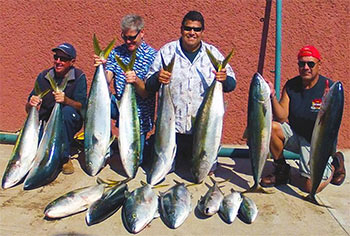
The data is in, and it probably should come as no surprise that after such a warm, dry weather pattern in the southwest this past spring, scientists are now predicting that a full blown El Niño condition will prevail over the Eastern Pacific this year; perhaps the most intense occurrence of the phenomenon in well over a decade. Reds crabs are already making a showing in the offshore waters along the northern Baja coast, and current surface fishing conditions seem to be about two months ahead of schedule. While this information may prove daunting to many, for coastal anglers in pursuit of hard-fighting pelagic species like tuna, dorado and yellowtail it sounds like a blessing.
At this writing, both yellowfin and bluefin tuna are being located by sportfishing craft in waters within 110 miles of the International Border, and anglers from southern California and Baja are hooking quality grade yellowtail from the Coronado Islands to points south all the way down the peninsula’s Pacific coast.
Near Ensenada, Capt. Louie Prieto of It’s 4 Reels sportfishing in Ensenada reports that a hot bite on yellowtail in the 20 to 30 pound class broke out recently just north of Islas Todos Santos. The frenzied action drew lots of diving birds and plenty of anglers, but those with a tank full of live bait had the definite advantage. Although there were a few fish taken on the iron, this was one of those times when anglers who didn’t bring their live bait with them were well advised to pull out the old Sabiki rig or ‘Lucky Joe’ and go after some of the smaller greenback mackerel in the area.
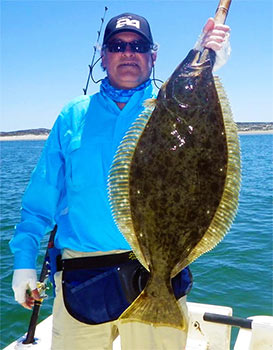
Situations like this are precisely the reason for my suggestion that all serious saltwater anglers fishing in the waters of Baja California always carry a few of these indispensable bait catch rigs in their tackle box with them at all times; because you never know when you might need one to ‘save the day’ when artificial lures and dead bait just won’t get the job done.
Further down the coast, local panga camps between Punta Banda and San Quintin continue to score well on lingcod, reds and other bottom fish, as well as the occasional barracuda, bonito and yellowtail.
In Bahia San Quintin, Capt. Kelly Catian at K&M Sportfishing indicated that the yellowtail bite has been wide open, with plenty of quality rockfish also available to help break up the day. There have also been a few nice halibut taken around the oyster farm out near the mouth. Word came late this week that Capt. Oscar Catian headed a few miles south of the Bahia’s entrada and ran into a few white sea bass in the 20 to 25 pound class. This early showing bodes well for the local sea bass bite, which generally peaks in late August with fish that often can weigh upwards of 50 pounds.
Jose Angel of Cedros Outdoor Adventures says that calico bass and yellowtail fishing around Isla Cedros is quite productive and looks like it will only get better as the months progress.
Back on the mainland of Baja’s central coast, Shari Bondi at the Blowhole Bed & Breakfast in Bahia Asuncion reports that, although the weather has been a bit cool and windy from time to time, there is still some excellent calico bass fishing in the local kelp with a few yellowtail making an occasional appearance. For those who prefer to fish onshore, there has also been good fishing for halibut from the beach. Those casting into the suds with a shiny Krocodile spoon on a fluorocarbon leader have been the most successful at this pursuit.
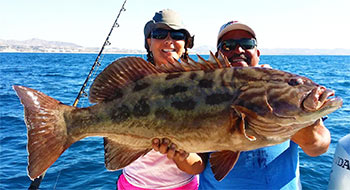
Down near the tip of the peninsula, charter boats pursuing billfish out of Los Cabos report hot weather and multiple marlin hook ups for a majority of their clients. A few mile away at San Jose del Cabo on the Cortez coast, Eric Bricston at Gordo Banks Pangas says that large concentrations of billfish have been found a couple of miles out from the marina. Some charters accounted for 5 or 6 striped marlin a day, with sizes ranging from 80 to 130 pounds.
Trolling off Los Frailes has been productive for yellowfin tuna in the 100 pound class, with most of the schools being located under pods of cruising porpoise. There have also been some sporadic catches of smaller dorado off the local high spots. Trolling rigged ballyhoo and Rapala lures have provoked a majority of the strikes from these fish. There is a good roosterfish bite off the beach as well, although it has been a bit spread out due to a lack of live mullet in the region. A little bit up the Cortez coast at Rancho Leonero, owner John Ireland is extremely pleased with the way this fishing season has progressed so far. “The marlin fishing has been excellent!” exclaims Ireland. “Perhaps the bigger news of the week was the arrival of the first big blue marlin. Angler Kevin Toohey released a 300-pounder on May 24th. The other good news is the appearance of a few sailfish.”
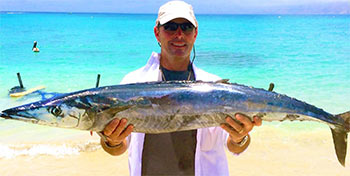
“Dorado continue on a very good bite, with the fish all over the waters of the East Cape. These fish are slightly bigger, and we all know how fast they grow; so there are high hopes of a grand dorado season! The tuna are also starting to show, with fish taken on most days. The best bet has been 25 miles straight out, where our boat Moho got into a school of fish slightly larger than football size. I am anticipating good tuna fishing soon with all the signs in place early this year.” Ireland concluded his report by saying, “Big pargo are coming to gaff near the banks off La Ribera. Mixed in with these were some good amberjack in the 50- pound class; fish that will definitely put a bend in your rod and curl your hair. The iron lures were working best when jigged at about 150 feet.”
Further north in La Paz, John Roldan at Tailhunter international indicated, “The fishing conditions have varied from location to location. One day our Las Arenas fleet will be top-dog for fish and action. Next day, Las Arenas will be tough, and our La Paz fleet will be rocking the fish. Similarly, two pangas next to each other might be fishing and doing the exact same thing or working the same beach or patch of water. One would hook up left-and-right. The other would have guys scratching their heads wondering if they had unlucky bananas aboard. There has just been no predicting from day-to-day or from location to location. But that should change.”
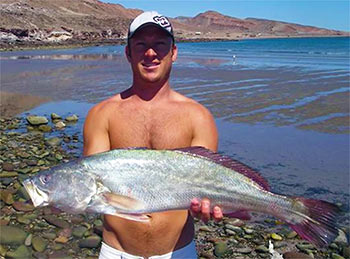
Roldan added, “The two biggest stars that came through were our dorado, especially for our La Paz anglers, with fish up to 40 pounds, but so many fish lost! It made the counts very deceiving! Our fishermen would come in with some sad stories and only 2 or 3 fish. Then, I would check with our captain and he would say, “But they had lots of opportunities! They LOST 7 fish!” Well…that’s a big difference!
The best news has been the rooster fish. The roosters around Las Arenas have been biting really well. Fish have generally been 20 to 50 pounds, which is nothing to sneeze at; but we also got some fish in the 60 to 70 pound class and even one estimated at 80 to 90 pounds! Of course, all those fish were released.”
Further up the coast, the yellowtail bite has remained a bit picky with most anglers eventually dropping down several hundred feet to fish the bottom for pargo and cabrilla. Similarly, the Midfriff Islands off of Bahia de Los Angeles have yet to come into their own, but in the next few months things will take a turn for the better up there as well.
At the northern end of the Sea of Cortez, although air temperatures are often in triple digits, the onshore fishing along the beaches between Puertecitos and Punta Final and be phenomenal at times, particularly for orangemouth corvina. The bite usually extends into early fall, but this year may lasting longer; as might also be the case around the entire Baja California peninsula.

Yara is very helpful and explains everything. Love working with companies like this.

Honestly their app is so fantastic and saves all my info I can literally buy the same insurance for...

No claims but purchase was quick and simple.